UNIT 3:JOUNALIZING FINANCIAL TRANSACTION
Key unit competence: To be able to journalize financial transactions
Introductory activity
Peter MUGABONAKE is a sole trader in Muhanga, selling construction
materials. During the year 2021, he had made a number of transactions
and thought he had earned a good profit but did not know how much.
This is because he was not aware of sales realized during the period and
purchases made. He also had neither idea on other income nor expenditure
for the same period. Besides, it was very hard for him to know what to
plan for the forthcoming year. He advised himself to go for deep checking
on invoices for the period, but failed because some disappeared! Due to
that critical situation, he was late to declare and pay tax and consequently
charged and paid penalties. What was a mistake Peter MUGABONAKE
did? What is your advice to him? What do you think as a sustainable
answer to avoid that mistake from happening again?
In principle, transactions must be recorded daily into the books or the accounting
system. For each transaction, there must be a document that describes the
business transaction. This unit describes first the double entry bookkeeping
system and later the books of original entry used before posting transactionsinto ledgers which will be covered under unit 4.
3.1. Double-Entry Bookkeeping System
Activity 3.1
Suppose that you are hired as a book keeper of a given shop in your locality.
You are required to identify a suitable bookkeeping system that will help to
produce good financial reports and explain your choice.
3.1.1 Meaning of Double Entry Bookkeeping System
It is a recording system in which there is dual recording of transactions. Under
a double entry bookkeeping system, a transaction must be recorded twice ie. in
two accounts or books. The principle or the rule of the double entry states that
for every debit entry there must be a corresponding credit entry and for every
credit entry there must be a corresponding debit entry. For each transaction total
debits must equal total credits. Double entry is very important in accounting.
Failure to conform to the rule of double entry will mean that accounts including
the balance sheet will not balance.
Debit and credit
Under double entry system accounts are debited and credited. It is important at
this time to understand what these words mean. Debit and credit are means of
either increasing or decreasing an account. They replace plus or minus used in
arithmetic. Depending on the nature or type of an account, debiting or crediting
could mean either increasing or decreasing it.
An Account
An account is a record in a summarized form and in chronological order of
transactions that took place in an organization. It is a heading under which
related transaction are brought together i.e. different transactions are classified
into their respective accounts.In manual accounting systems, accounts are recorded in “T” form.
Eg:
It is conventional that the left hand side of an account is the debit side while the
right hand side is the credit side. The words debit and credit may not have to
be reflected in the account because it is common knowledge that the left hand
side is debit and the right hand side is credit.
In the computerized accounting system, an account is written with a runningbalance as shown below:
Classification of Accounts
Accounts in the ledger are mainly classified into two categories namely:
a) Personal accounts
b) Impersonal accounts
These accounts will be opened according to the requirements of the business.Below is an illustration to show the classification of accounts

They are explained as below:
Personal Accounts
These are accounts, which have names of business, persons or firms. They
mainly fall under debtors’ accounts, creditors’ accounts, drawings and capital
accounts.
a) Debtors’ accounts: These records the accounts of person or organization
to whom the business has sold goods on credit or to who the business
has extended another credit.
b) Creditors’ accounts: These record the accounts of persons or
organizations from whom the business has bought goods on credit or
from whom a business has taken another credit.
c) Drawings account: Drawings is a term used whenever the business
owner reduces: the business resources for his personal/ private use.
Drawings reduce business funds and therefore the drawings account is
treated as a reduction in capital. It is debited whenever a drawing is made.
At the end of financial period all entries of drawings are added up and the
total debited on the capital account. This implies that the capital account
(owner’s resources in the business) is reduced to the extent of drawings.
In addition, when the owner takes out some of the goods for his own use;this debits drawings account and credits purchases account.
d) Capital Account: This account will record the transactions of the
business and the proprietor/ owner. Thus any amount invested by the
proprietor is recorded in this account.
Impersonal Accounts
a) Real Accounts: These are accounts which record tangible items i.e.
physical items or things which we can see, touch or feel. They are
mainly assets accounts like Land, machinery, motor vehicles, cash,
stock, etc.
b) Nominal Accounts: These are accounts which record intangible
items i.e. they record things which we cannot see physically, touch or
feel. They are either expenses or incomes accounts. Eg. Rent, Salaries,
interests received, discount received, sales, purchases, etc
The following table is useful in understanding double entry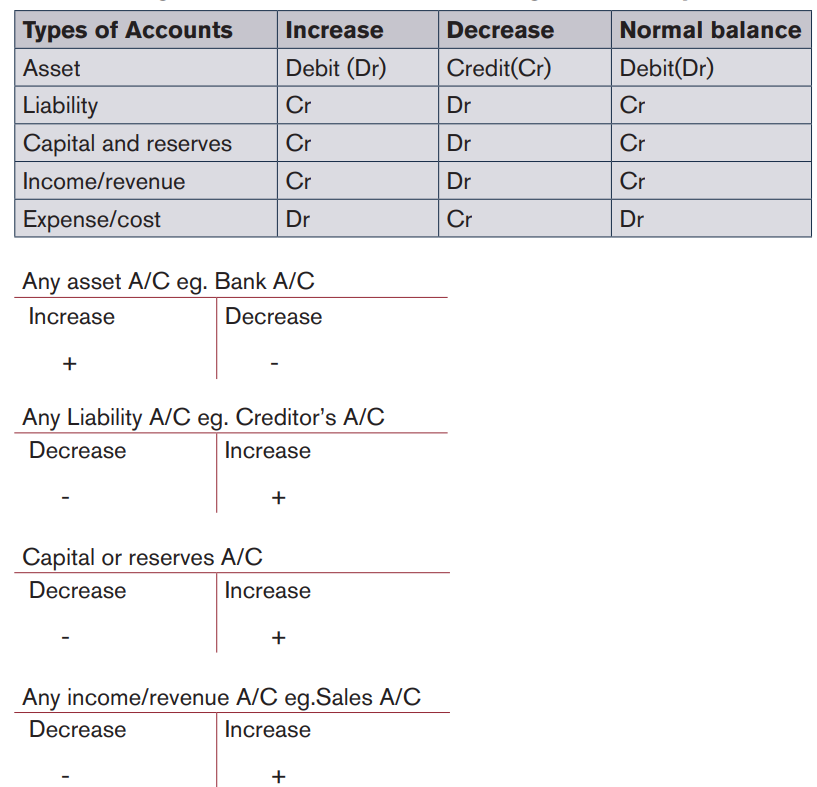
Accounts and Double entry
A classification of accounts enables us to establish rules for making double
entry. When completing double entry three points should be considered:
a) What two accounts are affected?
b) What types of accounts are they?
c) Which account is to be debited and which account is to be credited?
Nature of ledger balances
Debit balances: These may be classified as assets, expenses or losses
Credit balances: These are classified as liabilities, incomes and gains.
Determination of the accounts affected and Description of the impact
on the accounts (increases or decreases)
Example
Identify the accounts affected by the following transactions and show action to
take when recording the accounts in the double entry system.
1. Owner puts cash into business
2. Paid creditor KAGABO by cheque
3. Bought goods on credit from Wellars
4. A debtor KARAKE paid us in cash
5. Received rent payment in cash
6. Owner withdraws cash from business for personal use
7. Paid commission by cheque
8. Bought furniture on credit from Omar
9. Sold goods receiving cash payment10. Bought goods paying in cash
11. Sold goods on credit to KARAKE
12. Some of the goods bought from Omar were returned back to him for
default reasons
13. KARAKE returned to us some of the goods bought, as they were inexcess of his order.
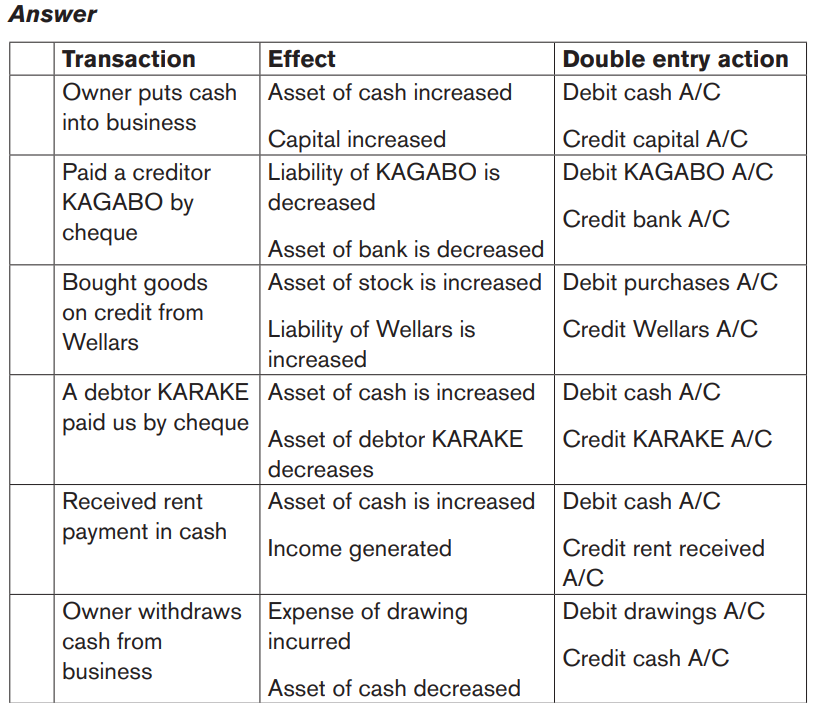
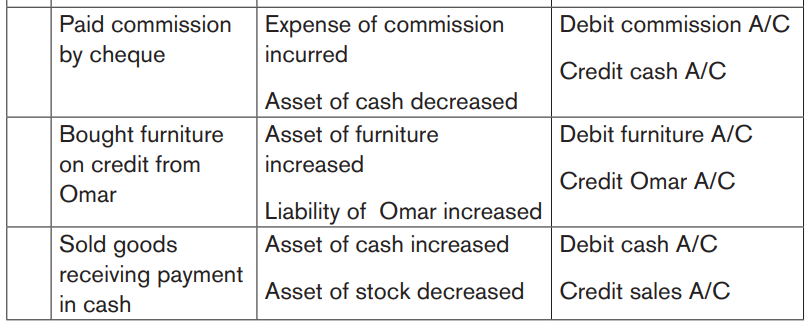
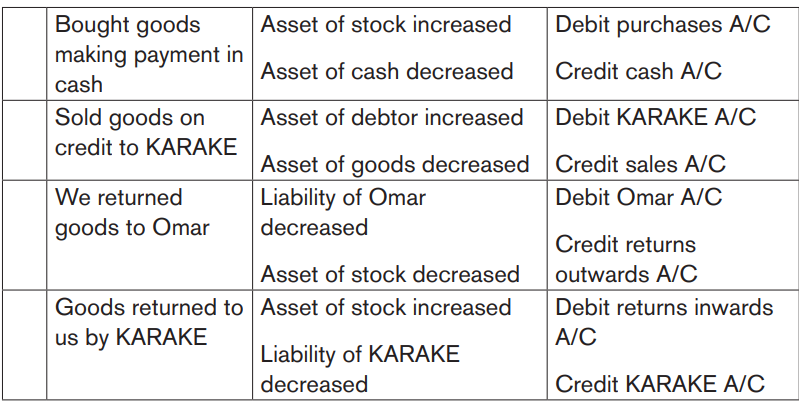
Application activity 5.1
1. Write short notes on the following:
a) Personal account
b) Real account
c) Nominal account.
2. From the following names of ledger accounts in the books of a
trader, rule columns headed assets, liabilities, Gains and expensesin each column place the right items.
4. Complete the following table, identify the accounts affected by
each transaction, and state whether the account is to be debited orcredited.

3.2 General Journal
Activity 3.2
Referring to the knowledge gained from entrepreneurship O Level describe
the general journal and give its format.
Activity 3.2
This is the book of original entry also known as journal proper or principal
journal, which is used to record items of a non-routine nature which cannot be
recorded in other book of prime entry. Unlike the subsidiary books, transactions
in the general journal are entered on a double entry basis and in order of theiroccurrence. It is ruled with columns for date, details, folio and debit and credit
amount columns and each transaction recorded therein is a true reflection of
how such a transaction will appear in the ledger. A debit entry in the journal is
still a debit entry in the ledger and likewise, a credit entry in the journal will be
a credit entry in the ledger for accounts concerned. Even though the journal
is operated on double entry lines like the ledger, it means subsidiary to the
ledger. Whatever is entered in the journal has to be transferred to the ledger for
permanent record.An illustration of a general journal format is as shown:
A journal entry must have a narration which is a brief explanation of what has
taken place. The narration gives some reason why one account has to be
debited while the other is credited and also some reference as the origin of the
transaction.
Notes:
Details/Account title: the name of the account involved in the transaction is
entered in this column plus a narration or explanation of the transaction.
Folio: this column shows the reference where the account can be found in the
ledger especially the page number of the account in the ledger. At times instead
of using folio, LP standing ledger page is used. In real World, this column is
largely referred to as reference.
Date: Dates at which transactions occurred are entered into this column.
Use of a general journal
The general journal serves many useful purposes such as the recording of:
– Opening balances at the beginning of a financial period
– Purchase or sale on credit of non-trading items like non-current assets.
– Correction of errors made during the recording of transaction, balancing
and closing accounts in the ledger.
– Transfer of amounts from one account to another in the ledger
– Adjustments in accounts in respect of items relating to succeeding and
preceding periods not connected with the present accounting period,
which have not been taken into account.
– Adjustments at the close of the period(e.g depreciation, bad debts,
interest on capital)
– Closing accounts of a business at the end of its financial period.
Preparation of the General Journal
Illustration
The following transactions are for AKEZA LTD for the month of October 2021.
Enter them into a general journal.
Oct. 1 Started business with FRW 20,000,000 cash
Oct. 2 Purchase land for the business at FRW 3,000,000 by cash
Oct.4 Purchased office equipment on credit from Equipment Suppliers Ltd at
FRW 2,000,000
Oct. 5 Obtained bank loan of FRW 8,000,000 it was deposited to a bank A/C
Oct.15: Made part payment of FRW 1,500,000 to Equipment Suppliers Ltd by
cheque.
Oct. 17: Bought motor vehicle from TOYOTA RWANDA at a cost of FRW
15,000,000
Made cash payment of FRW 10,000,000, paid FRW 3,000,000 by cheque and
promised to pay balance later
Oct. 20: Sold a portion of land that was fully un-utilized for cash FRW 500,000
Oct. 25: Fully settled the balance of FRW 2,000,000 by cheque due to TOYOTA
RWANDA for the motor vehicle
Oct. 30: FRW 800,000 business cash was used to entertain relatives fromupcountry
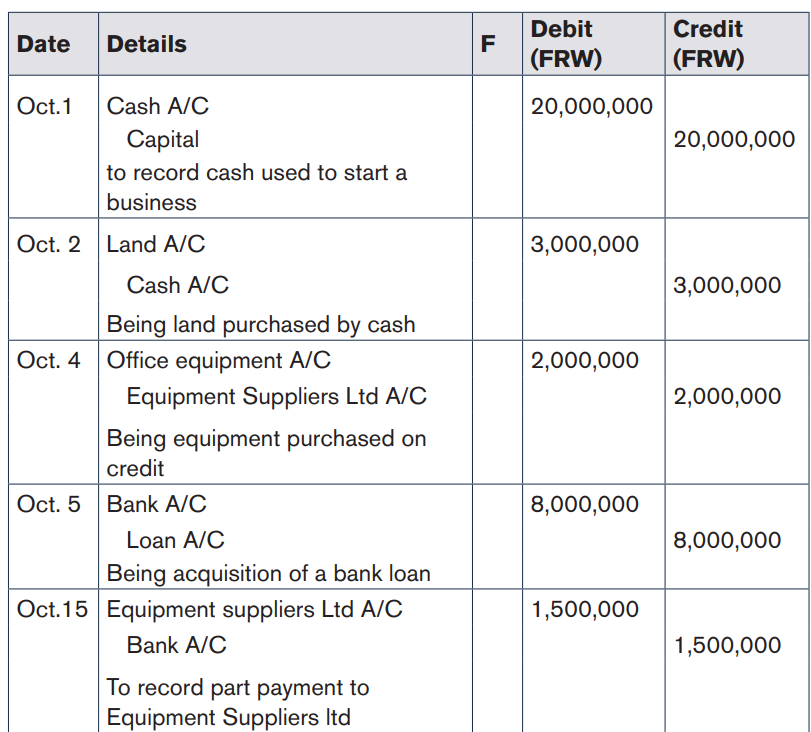
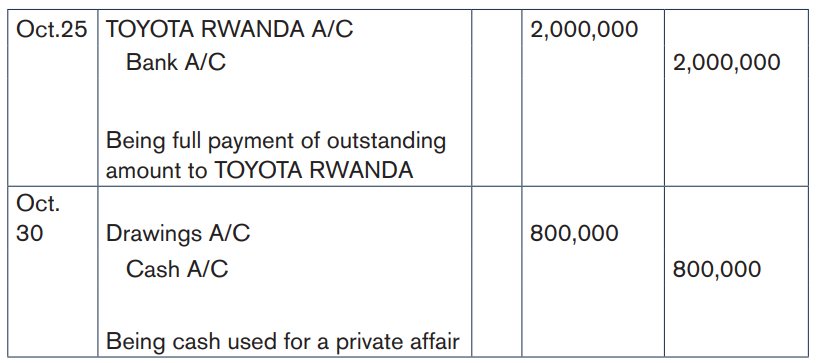
Record of opening balances
The journal proper is used to record the opening balances of assets, liabilities
and capital before they are posted to the respective ledger accounts. Where
capital is not known at the start of the period and where assets and liabilities
are given the opening journal helps to ascertain that capital. The double entry
system establishes a balancing concept in accounting (i.e. total debits should
always equal to total credits). Therefore, Assets= Liabilities + Capital as assets
are debits whereas liabilities and capital are credits. The journal is thus debited
with assets items and credited with liabilities items. The amount needed to strike
the balance on the credit side is capital
Example 1
Miss KEZA, commenced business on January 2022 with a Toyota pick-up van
valued at FRW 27,500,000; land at FRW 50,000,000 and cash in hand FRW
100,000,000. She also owed FRW 7,000,000 to her sister SIFA for money lent.You are required to record an opening entry for Miss KEZA
Assets= Liabilities + Capital
Assets: 27,500,000 + 50,000,000 + 100,000,000 = 177,500,000
Liability = 7,000,000
Capital = Asset - liability
Capital = 175,000,000 - 7,000,000 = FRW 170,500,000
Example 2
Pass entries in the general journal to record the following transactions:
a) Purchase a delivery van worth FRW 202,500,000 from
RWANDAMOTOR paying half amount by cheque
b) Took out of stock of goods valued at FRW 100,000 for own use.
c) A credit note issued to Jane B. for FRW 30,000 was posted to the
credit of Janine B.
d) The bank statement indicated bank charges of FRW 15,000 which I
had not yet recorded in the books.
e) An invoice received for a credit purchase of furniture for FRW 800,000debited to purchases account
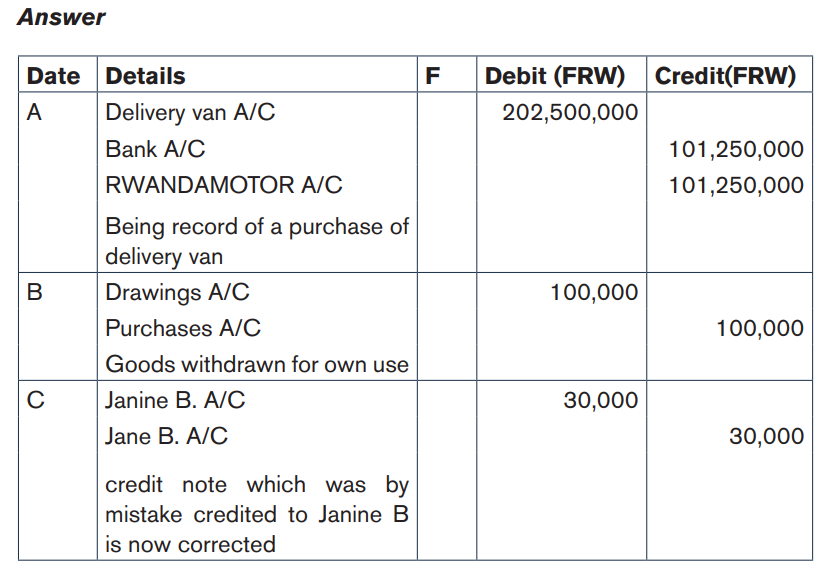
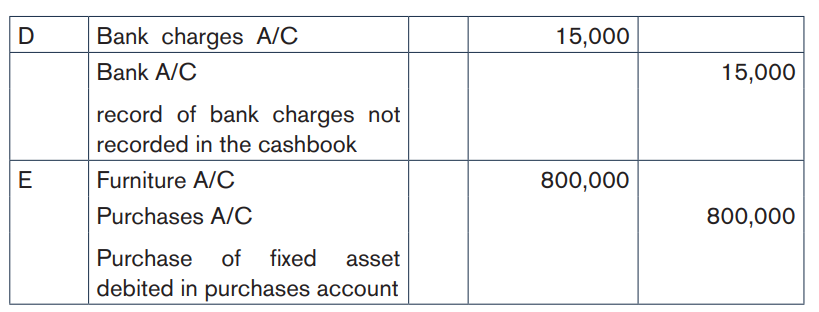
3.2.1 Journal entries for VAT
What is VAT?
Value Added Tax (VAT) is a tax charged on the supply of goods and services in
Rwanda. The concept underlying VAT is that the tax is paid by ultimate consumer
of the goods or services but that everyone in the supply of chain must account
for and settle up the net amount of VAT they have received in the VAT tax period
usually one month. If they have received more in VAT than they have paid out in
VAT, they must send the difference to Rwanda Revenue Authority. If they have
paid out more than they have received, they will be reimbursed the difference
(known as VAT refund). The rate of VAT in Rwanda is 18%. The following exhibitshows, through an example, how the system works

In the above example,
1. A manufacturer sells a table to a retailer for FRW 100 plus VAT of FRW
18
2. The retailer pays the manufacturer FRW 118 for the table
3. The VAT on that sale (FRW 18) is sent by the manufacturer to Rwanda
revenue Authority (RRA)
4. The retailer sells the goods to customer (i.e. the consumer) for FRW 120
plus VAT of FRW 22.
5. The customer pays FRW 142 to the retailer for table.
6. The amount of VAT paid for the goods by retailer to the manufacturer
(FRW 18)is deducted from the VAT received by the retailer from the
customer (FRW 22) and the difference of FRW 4 is then sent to RRA.
Only the ultimate consumer has actually paid VAT. Unfortunately, everyone in
the chain has to send the VAT charged at the step when they were in the role
of seller. In theory, the amount received in stages by Rwanda Revenue Authority
will equal the amount of VAT paid by the ultimate consumer in the final stage of
supply chain.
VAT paid on inputs (purchases) is called input VAT or VAT deductible while
VAT received from sales is known as output VAT or VAT collectible
The VAT Account
All registered business must account for VAT on all the taxable supplies they
make and all the taxable goods and services they receive. They must also keep
a summary (called a VAT Account) on the totals of input tax for each VAT tax
period. All these records must be kept up to date.
Journal entries for VAT
Example 1
A construction materials Shop (NYACOM) situated in Nyarugenge District
sold materials of construction to Mr KALIMA of MUHANGA District valued at
FRW 972,500 VAT included according to the information on the invoice No
075/C.M/2021 sent by NYACOM to Mr KALIMA.
Required: Calculate the VAT charged and record the transaction in generaljournal of NYACOM.
Answer:
Example 2
The following transactions have been made by MGK Ltd. You are required to
journalize them.
a) 10/1/2022 Bought goods for FRW 16,520,000 inclusive of VAT on
credit to ABC Ltd.
b) 25/1/2022 Sold all the goods bought on 10/1 for FRW 18,000,000
before tax by cheque.
c) 15/2/2022 Declared and paid the VAT to Rwanda Revenue Authority
(RRA) by cheque.
Note: the VAT rate being 18%.
Answer:
a) VAT= 16,520,000x18/118= 2,520,000
Net amount from VAT= 16,520,000- 2,520,000 = 14,000,000
b) Net amount = 18,000,000
Add: VAT 18%= 3,240,000
Amount with VAT 21,240,000
c) VAT payable = VAT collectible- VAT deductable= 3,240,000 - 2,520,000 = 720,000
3.2.2 Journal entries for payroll information
Salaries and wages usually form a substantial part of a business's expenditure,
especially in service organisations. However, salaries and wages expenditure
does not arise in the same way as other cash and credit purchases.
The entries in the accounting system that are made in respect of salaries and
wages are known as payroll transactions.
To understand payroll transactions, you need to have a basic understanding
of the main statutory and voluntary transactions which are processed through
payroll.
Gross pay:
Gross pay is the total amount that the employer owes the employee before any
deductions have been made.
Statutory deductions:
Income tax and employees' social security contributions are known
as statutory deductions from gross pay, because the law (statute) requires
employers to make these deductions from individuals' salaries.
Employees pay their income tax under the income tax system. This means that
each time an employee is paid by their employer, the income tax for that period
(eg monthly) is deducted from their wages by the employer. At regular intervals
the employer then pays the income tax over to the tax collecting authority on the
employees' behalf.
Employees must also pay employees' social security contributions to the tax
authorities. Social security contributions are just another form of tax, calculated
differently from income tax. An individual employee's social security contributions
are deducted from the employee's wages and paid over to the tax authorities,
together with the employee's income tax.
Voluntary deductions
An employee may choose to have other (voluntary) deductions made from gross
pay. These items can only be deducted from an employee's gross salary if the
employer has the employee's written permission to do so.
For example, if an employee chooses to make pension contributions, this money
is deducted from gross pay and transferred to a pension administrator to provide
a pension for the employee on retirement.
Other voluntary deductions include the repayment of a loan from the business
(for example, to repay a season ticket loan for travel to work).
Net pay
Once all deductions have been made, the amount paid to the employee is called
net pay. It is sometimes referred to as 'take home pay'.
Employer's social security contribution (statutory)
The employer is also required to pay an additional amount of social security
contributions for each employee, known as the employer's social security
contributions. This is yet another form of tax, but the difference is that it is only
suffered by the employer. There is no deduction from the employee's gross
pay for the employer's social security contributions. Employer's social security
contributions are paid by the employer to the tax authorities.
Employer's pension contribution (voluntary)
The employer may make a voluntary contribution to the employee's pension.
Again, this is in addition to the gross pay. Therefore, it increases the 'total cost'
of employing individuals. However, it is not deducted from the gross pay.
Accounting for Payroll transactions
Payroll is accounted for using the double entry bookkeeping rules that we are
familiar with. The following example is a simple illustration of recording payroll
transaction in the context of Rwanda. Note that the example includes RSSB
maternity leave contribution which was not talked about in the above deductions,however it is a common statutory deduction in Rwanda.

3.2.3 Types of discounts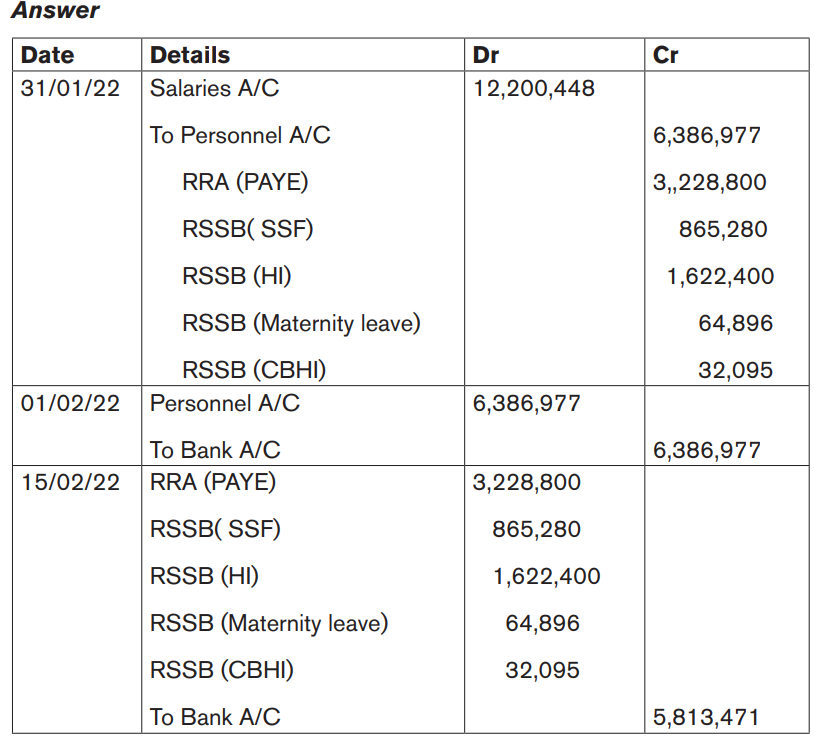
Discounts can be defined as follows:
A trade discount is a reduction in the listed price of goods, given by a
wholesaler or a manufacturer to a retailer. It is often given in return for bulk
purchase orders.
A cash(settlement) discount is a reduction in amount payable in return for
payment in cash, or within an agreed period.
Examples are given below
i) Trade discount
It is discount that you receive from the seller at the time of buying goods
(may be because of buying higher quantity or due to your business relations
with the seller etc) and the same is deducted or adjusted in the invoice. The
supplier’s invoice states the actual amount payable, net of trade discount.
E.g: Gross sales: FRW 700,000
Trade discount: 5%
Calculation:
Gross sales 700,000
Trade discount (5%) 35,000
Net sales 665,000
Accounting treatment of trade discounts
Trade discounts are not recorded in the accounting books. The net amount of
invoice will be used in recording the goods purchased or sold.
In the books of supplier:
Dr: Debtor A/C 665,000
Cr: Sales A/C 665,000
In the books of debtor
Dr: Purchases A/C 665,000Cr: Suppliers A/C 665,000
ii) Cash discount
It is a reduction allowed to a customer who pays before the end of credit period.
A credit period is a length of time that a customer is allowed to delay payment.
The customer qualifies for the cash discount only when he pays before the end
the credit period but within agreed period of time.
Note: cash discount is always recorded in the books of accounts.
Cash discount is in two types: Discount allowed and discount received.
Discounts allowed: they occur when the company accepts the payment
from a customer of a lesser amount than the amount due because he paid
promptly. It is treated as an expense because it reduces the amount charged to
the customer.
Dr: Discount allowed A/C
Cr: Debtors A/C
At the end of the accounting period, the balance on the discount allowed
account is transferred to the debit of the profit and loss account as an expense.
Besides when it is received from the supplier, it is called discount received
and it is treated as an income because it reduces the obligation toward the
supplier and it is recorded as under:
Dr: Suppliers A/C
Cr: Discount received A/C
Example 1
Albert has sold goods to William on credit for FRW 5,000,000.it is then agreed
that if William pays within 20 days of his purchase, he can receive 10% as
discount. If William performed payment within 20 days, show the journal entries
for both parties.
Answer:
a) In the books of Albert (seller)
Dr: Cash A/C 4,500,000
Discount allowed 500,000Cr: Debtors (William) A/C 5,000,000
b) In the books of William (buyer)
Dr: Suppliers (Albert) A/C 5,000,000
Cr: Cash A/C 4,500,000
Discount received A/C 500,000
Example 2
On 20th January 2022, Denis purchased from Alfred 1000 units of item at FRW
5300 each. As Denis is a regular customer, Alfred has to offer 2% discount for
bulk purchase and 5% discount for immediate payment.
Determine how much has invoiced to Denis and show the accounting entriesfor both parties.
Answer:
Calculations: Total sales: 1000x5300 = 5,300,000
Less trade discount (2%) 106,000
5,194,000
Less cash discount (5%) 259,700
Net cash paid by Denis 4,934,300
Journal entries
a) In the books of Alfred ( the seller)
Dr: Cash A/C 4,934,300
Discount allowed A/C 259700
Cr: Sales A/C 5,194,000
b) In the books of Denis ( Customer)
Dr: Purchases A/C 5,194,000
Cr: Cash A/C 4,934,300Discount received A/C 259700
Application activity 3.2
Enter the following transaction into the general journal properly showing
the double entry. The transactions are for AKANYANA Ltd for the month of
January 2022
Jan.1 Bought goods on credit from Peter for FRW 400,000
2 Bought goods on credit from Jane for FRW 200,000
3 Sold goods to John on credit for FRW 1,000,000
4 Sold goods to Mary on credit for FRW 400,000
5 Returned goods worth FRW 50,000 to peter because they were defective
10 Received part payment of FRW 800,000 cash from John for goods
taken on credit
12 Made part payment to Peter FRW 80,000 cash
14 Purchased goods for FRW 60,000 on credit from Jane
15 Mary rejected and returned goods worth FRW 40,000
16 Received a cheque of FRW 150,000 from Mary as part for payment for
goods taken on credit
17 Paid rent cash FRW 100,000
18 Returned goods worth FRW 50,000 to Jane because they were
defective
17 Paid rent cash FRW 100,000
18 Returned goods worth FRW 50,000 to Jane because they were
defective
19 Paid Jane FRW 150,000 by cheque
20 Sold goods to John on credit for FRW 800,000
22 Bought goods for FRW 100,000 paying cash
23 Sold goods cash FRW 500,000
24 Sold goods for FRW 4,000,000 receiving payment by cheque
immediately.
25 Purchased goods for FRW 100,000 from Peter
26 Paid Peter FRW 80,000 cash
27 John rejected and returned goods worth 100,000
28 Received a cheque of FRW 200,000 from John for goods sold to him
on credit
29 Paid for electricity FRW 50,000 by cheque and FRW 100,000 cash
30 Paid rent FRW 60,000 by cheque31 Paid salaries FRW 150,000 cash and FRW 160,000 by cheque
3.3 Sales Journal
Activity 3.3
Describe the books of original entry which records credit sales of goods
Sales day book/Sales Journal
This is the book of original entry in which daily credit sales are recorded from
copies of invoices issued to debtors before posting to the ledger. Each credit
sale is recorded in chronological order in the sales daybook, the personal
account of the customer in the ledger is debited with the amount of sale. At the
end of the week or month or any other posting period, the sales journal is totaled
to ascertain the total credit sales for the period. This total is then credited to the
sales account in the ledger, thus completing the double. If the posting is done
accurately, the sum of individual amounts to the individual customers’ accounts
in the ledger should agree with the amount of credit sales.Format of Sales Journal or Sales Daybook

Example 1
The following credit transactions took place in the firm of AKALIZA during the
month of February 2022.
Feb. 2 Sold 50 sacks of Cement at FRW 10,000 each on credit to BAHIZI
Feb. 2 Sold 70 sacks of cement at FRW 10,500 each on credit to Horizon Ltd
Feb 3 Sold 500 sacks of cement at FRW 10,500 each on credit to Fair
Constructors Ltd less a 2% trade discount.
Feb 10 Sold 600 sacks of cement at 10,200 each on credit to Real Constructors
Ltd, receiving half the amount in cash.Answer
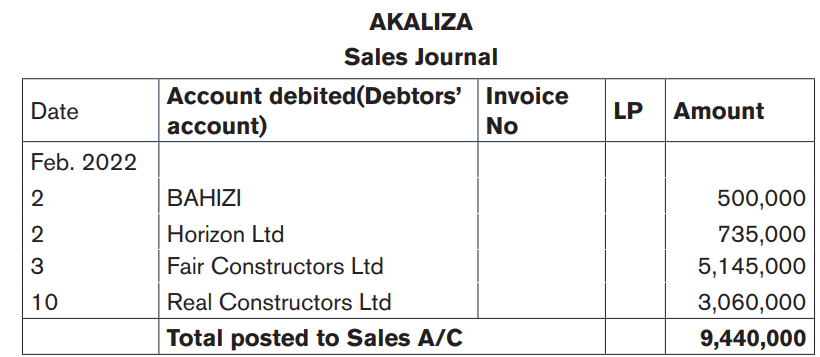
Example 2
A company sold goods to the following people on credit during the month of
September 2021:
Sept. 1 John for FRW 450,000 Invoice No 301
4 BAHATI for FRW 1,000,000 Invoice No 303
6 Joseph for FRW 900,000 Invoice No 4047 Anitha for FRW 500,000 Invoice No305
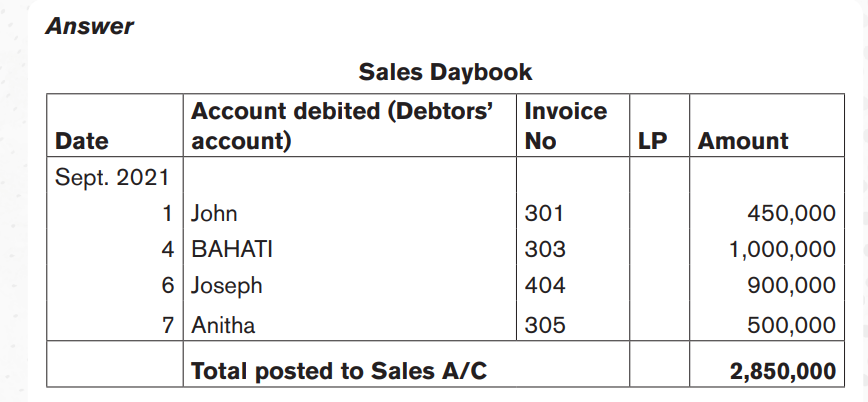
Application activity 3.3
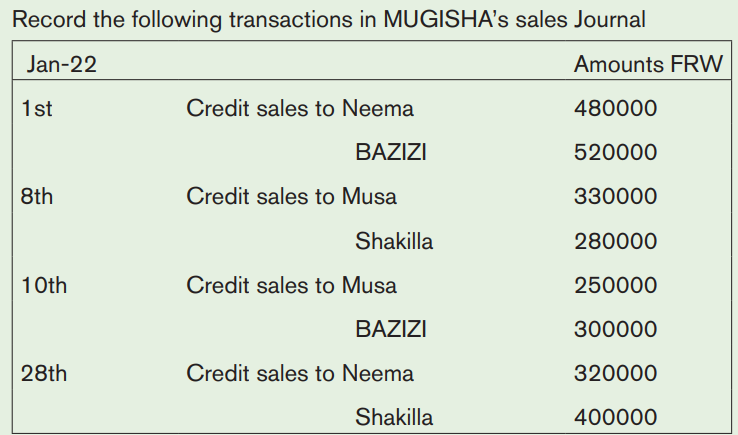
3.4 Purchases day book/ Purchases Journal
Activity 3.4
Referring to the competences acquired from senior two, describe the use
of purchases journal.
This subsidiary book contains day-to-day records, in chronological order, of
information on purchases. As each credit purchase is recorded from the invoice
into the purchases day book, the personal account of the credit supplier in the
ledger is credited. At the end of the month or other posting period, the total in
the purchases day book representing total credit purchases for that period, is
ascertained and posted to the purchases account in the ledger to record the
credit purchases in the ledger and also to complete the double entry. This debit
total extracted from the purchases day book should agree with the sum of the
individual amounts credited to the individual creditors’ accounts in the ledger. In
the details column of the purchases account in the ledger, the word “totals” is
used to indicate that it is a summary total posted and in the folio column, PDB isused to show that the total was extracted from the purchases day book.
Format of Purchases Journal
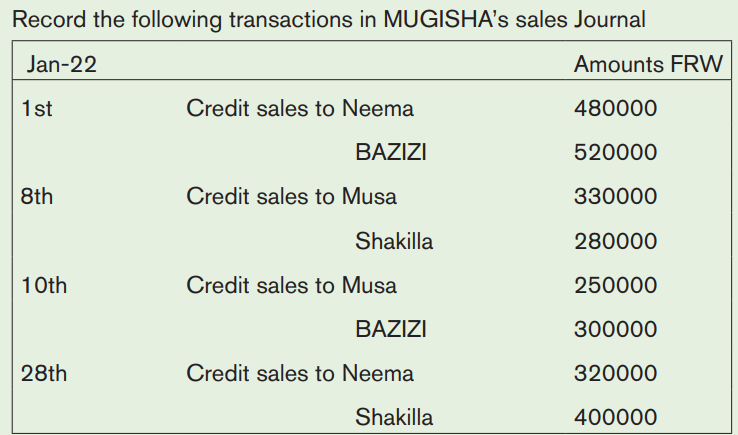
Example1
During the month of February 2022 AKALIZA had the following transactions in
its business:
February 1 Purchased 2000 sacks of cement at FRW 9,000 each on credit
from CIMERWA.
2 Bought 2,500 sacks of cement at FRW 8,500 each on credit from SIMBAcement less 2.5% trade discount
13 bought 1000 sacks of cement at FRW 9,200 each from HIMA cement on
credit.
Enter the above transactions in a purchases day book.
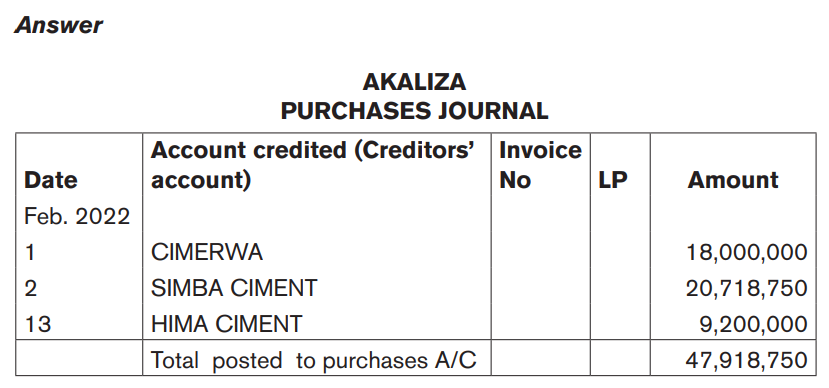
Example 2
Record the following transactions into the purchase journal
Jan. 1 Bought goods on credit from Tom for FRW 2,000,000 Invoice No 199
2 Bought goods on credit from Moses for FRW 4,000,000 Invoice No 200
8 Bought goods on credit from Josias for FRW 5,000,000 Invoice No 201
10 Bought goods on credit from Joy for FRW 10,000,000 Invoice No 202Answer
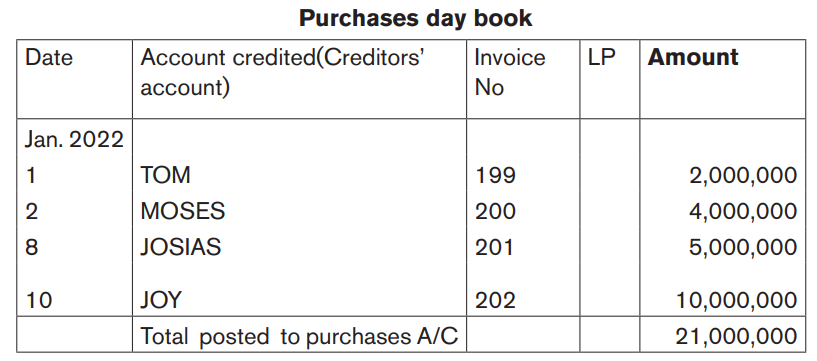
Application activity 3.4
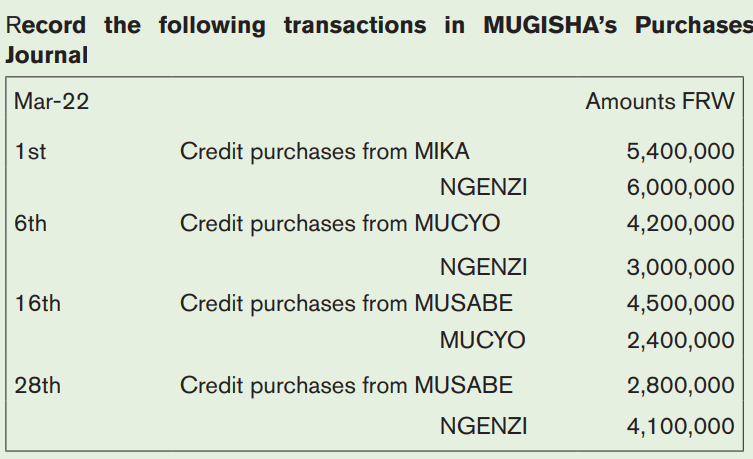
3.5 Sales Returns/Returns Inwards Journal
Activity 3.5
List as many reasons as you can think of why (a) retail customers and (b)
trade customers may return goods to the seller
This book is used to record credit note issued for goods returned to the seller
his/her credit customer. The individual items are recorded in the sales returns
day book as credit notes issued, and are immediately posted to the credit of
the personal accounts of the customers concerned in the ledger. At the end of
the posting period, the total in the sales returns Journal representing total sales
returns is debited to the sales returns inwards account in the ledger to completethe double entry and to record the sales returns in the ledger



Example 2
Record in a suitable book of prime entry the following transactions which took
place in the firm of AKALIZA for the month of February 2022
Feb. 5 BAHIZI returned 5 sacks of Cement worth FRW 10,000each sold to him
on 2nd February, credit note No 005 issued.
7 Horizon Ltd returned 3 defective sacks which they had bought on credit forFRW 10,500 each, credit note No 006 issued.
Answer

3.6 Purchases Returns/Returns outwards Journal
Activity 3.6
Suppose that your company needs to keep the separate books of prime
entry according to its transactions. Discuss the book of original entry underwhich credit notes received from your suppliers will be recorded.
Activity 3.6
This book is used to record particulars of all credit notes received from suppliers
in respect of goods returned by the buyer to the seller. Goods purchased
may be returned if they do not conform to the order as to quality, if they were
damaged in transit and credit is claimed from each supplier. Individual credit
notes received for goods returned are recorded in the returns journal in a similar
to purchases. At the end of the period, the purchases returns journal is totaled
to ascertain the total credit notes received for the period. This is then credited to
the returns outwards account in the ledger. If the goods returned were subject
to a trade discount, the necessary adjustment should be made when preparingthe returns advice claim for dispatch to the supplier

Example 2
The following are MUYIZERE’s transactions which he carried out in the month
of March 2022. Prepare his purchases returns day book.
1st March Bought goods from SULFO RWANDA 8 Cartons of Soap at FRW
87,500
5th March Bought goods from Omar 7 cartons of Naomi at FRW 8,700; cartons
of OMO at FRW 7,500
10th March Bought goods from 30 boxes of biscuits at FRW 2,500
20th March Bought goods from KABANDA 5 bags of sugar at FRW 55,000
25th March Returned to SULFO RWANDA 2 cartons of cowboy at FRW 9850
as damaged and 2 cartons of soap at FRW 87,500
30th March returned to KABANDA 3 bags of sugar at FRW 55,000 as damagedand 1 bag of salt at FRW 10,000.
Application activity 3.6
KAMUZINZI is a sole trader in Kigali, the following are transactions he
made during the month of June 2021.
June 1st Credit purchases from: Bertin FRW 2,500,000; Mathew FRW
14,500,000 Andrew FRW 35,000,000
4th Credit sales to: David FRW 41,000,000; Zouzu FRW 34,000,000;
Blaise FRW 27,000,000
10th Credit purchases from: Thomas FRW 14,700,000; Bertin FRW
10,000,000; Mathew FRW 19,000,000
12th Goods returned to Bertin FRW 3,500,000; Mathew FRW 5,000,000
15th Goods returned by Zouzu FRW 2,500,000; Blaise FRW 3,000,000
20th Credit purchases from: Thomas FRW 18,600,000; Bertin FRW
25,000,000; Mathew FRW 8,000,000
22nd Credit sales to: Zouzu FRW 15,000,000; David FRW 22,000,000
25th Goods returned to: Thomas FRW 2,000,000; Mathew FRW 1,500,000
30th Zouzu returned goods worth FRW 1,800,000You are required to prepare his returns outwards day book
3.7 Cash Book
Activity 3.6
KARUMUGABO a sole trader in your locality had numerous cash
transactions in his business, and needs to keep a separate book under
which cash and cheque transactions will be recorded, he asks you as
professional accountant to design a book that will help him to respond tohis need.
3.7.1 Nature and purpose of a cash book
Most of the numerous transactions of a trader involve the receiving and paying
of cash. There are many slogans displayed prominently in shop as “Pay Cash
Today, for Credit Come Tomorrow”. The commonest book of accounts is the
cashbook, which contains all records of payments and receipts of cash. Cash
here means bank notes, coins, money orders, credit transfers, cheques or other
form of monetary payment or receipt acceptable in settlement of business debts.
The cash book is said to be both a book of original entry and ledger. Thus, its
full name is cashbook ledger. It is a book of original entry because any receipt
or payment of cash is first recorded in this book before being posted to another
ledger account. It is important to note therefore that there is no subsidiary book
for cash transactions other than the cashbook, and credit transaction must not
be recorded in the cash book.
The cashbook is a ledger account because for every debit or credit entry made
in it, there must be a corresponding credit or debit entry in other accounts in the
ledger. Further, once a record is made in the cashbook, it is permanently kept
therein. The double entry rule applicable to recording entries in the cash bookis debit receipts and credit payments, which is consistent with the double entry
principle of debiting the account that is receiving value and crediting the one
giving value.
In brief, a business that keeps record of a cash book as an original book of entry
need not post separate bank and cash accounts into the ledger, as the cashbook serves the entire purpose.
3.7.2 Types of Cash Book
i) One-column Cash Book
One-column cash book is the simplest version of a cash book being a mere
ledger ruling with debit and credit columns and columns for dates, details, folio
and amounts as shown. On the debit side are entered all cash receipts and on
credit side the cash payments. This is a typical cash account for businesseswhich do not use and accept cheques.

Example
From the following transactions during the month of January, write Souzane’s one
column cash book. She started business on 1st January 2022 having transferred
FRW 9,600,000 from his private bank account to the business office.
January 1st Paid FRW 480,000 for rent for the month and made purchase of
FRW 3,830,000.
2nd Paid FRW 380,000 for stationery and FRW 192,000 for stamps
4th Cash sales FRW 1,728,000
7th Paid FRW 288,000 in respect of wages to assistant.
10th Borrowed FRW 4,800,000 from Joyce, a friend.
13th Bought a used Pick-up for FRW 9,216,000 from AKAGERA Garage
against FRW 1,920,000 deposit
19th Cash sales FRW 4,224,000
20th Paid wages for two weeks, FRW 576,000
23rd Bought FRW 6,240,000 goods from ABC Wholesalers Ltd. on credit
29th Drew FRW 2,880,000 for private use
30th Cash sales FRW 2,688,00031st Paid another FRW 5,760,000 off pick-up account.
Answer

ii) Two-column Cash Book
A two column cash book has two amount columns on each side of the book. On
the debit side, one column represents cash receipts, while the other represents
bank receipts. Similarly, the cash and bank columns appear on the credit side
to represent their respective payments.
The cash book is balanced by comparing totals of each account column on
either side in the same way the ledger accounts are balanced off.
Example
The following transactions were extracted from the books of KAGABO for the
period of March 2022.
March 1st balance brought forward
Cash FRW 2,400,000
Bank FRW 3,840,000
March 1st Paid rent cash FRW 240000
2 Made payments for telephone and postage by cash FRW 38,400
4 Paid cash for sundry expenses FRW 24000
8 Sold goods and was paid by cash FRW 5,920,000
10 Received payment by cheque from Naome MUKAMA FRW 384,000
11 Deposited cash in bank FRW 2,880,000
13 Payment by cheque was made to Barnabe FRW 2,025,000
20 Paid for advertisement in cash FRW 115,200
29 Sent cheque to William FRW 720,000
31 Drew a cheque for own use FRW 480,000
31 Paid FRW 1,248,000 cash into bank
Required: Show the above transactions in a two column cash book, balance itoff and bring down the balances.
Answer
KAGABO
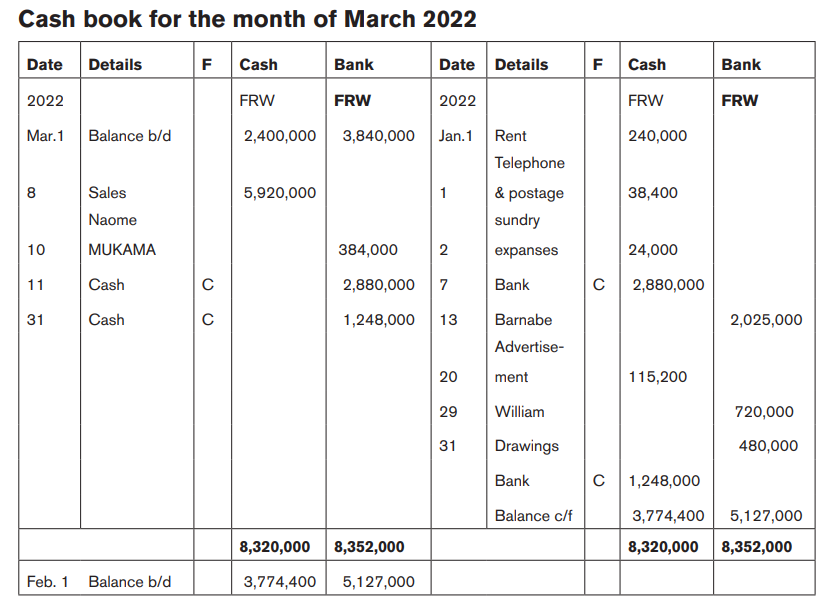
iii) Three column Cash book
A three column cash book has an additional column on the debit side, to
record discounts allowed and on the credit side the additional column records
discounts received.
Every debit entry made in the cash book for discount allowed has a corresponding
credit entry in the debtor’s ledger, in the account of debtor being allowed the
cash discount. Similarly, every credit entry of discount received made in the cash
book, has a corresponding debit entry in the creditor’s ledger in the account of
the creditor from whom discount is received.
At the end of accounting period, amounts in the discount column are separately
added up for each column. Note that the discount columns, unlike the cash
and bank columns are not balance off. Each discount column shows the actual
totals. The totals are then posted into the general ledger in the respectivediscount accounts
The total of discount allowed column is posted on the debit side of discount
allowed account. Likewise the total of the discount received columns are posted
on the credit side of the discount received account.
It is important for you to understand the alternative method whereby a three
column cash book is used. In this case, each individual discount entry is made
in the general ledger, in the concerned account, instead of posting of posting in
it only total amounts.
Example
Write up a three column cash book for KAREGEYA for details given below,
balance off at the end of the month and show the discounts accounts in thegeneral ledger in March 2022

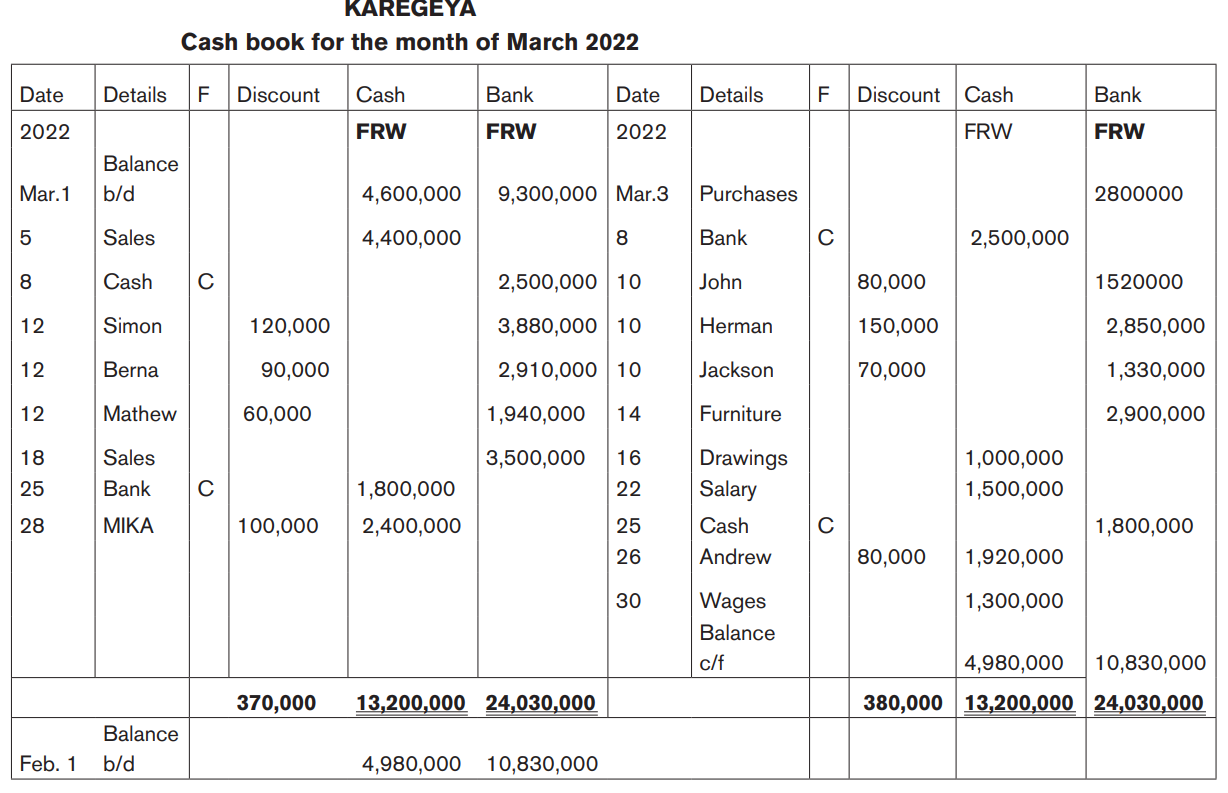
Note: Cheques drawn for own use must not be treated as a contra since this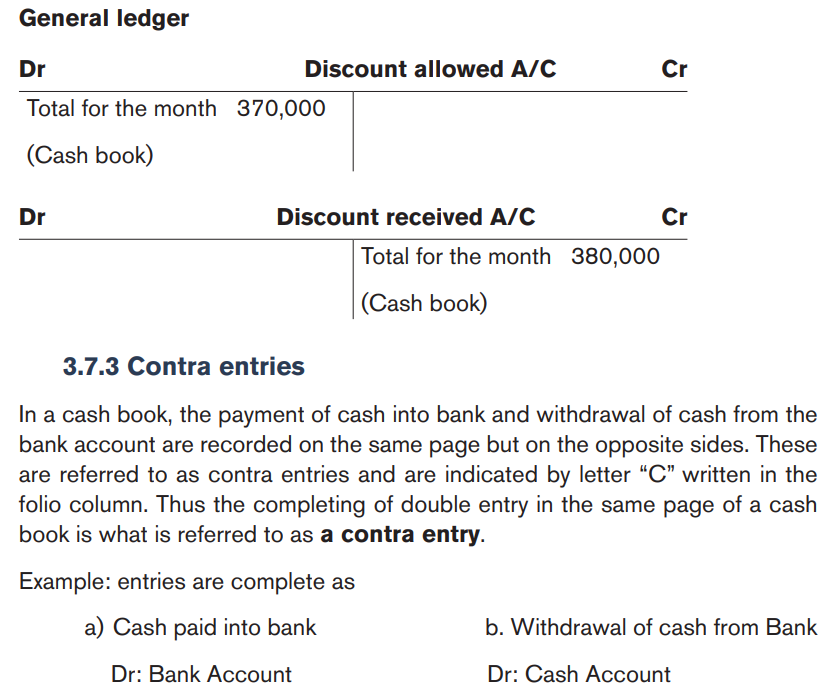
is for personal use and not for office use; hence the debit entry is made in the
“Drawings Account”. A contra is also defined as the balance of an account that
represents a deduction from another account e.g. provision for depreciation,bad debts, reserves, etc.
Application activity 3.7
From the following transactions enter the relevant transactions inthe cash book and open up the ledger for discount accounts
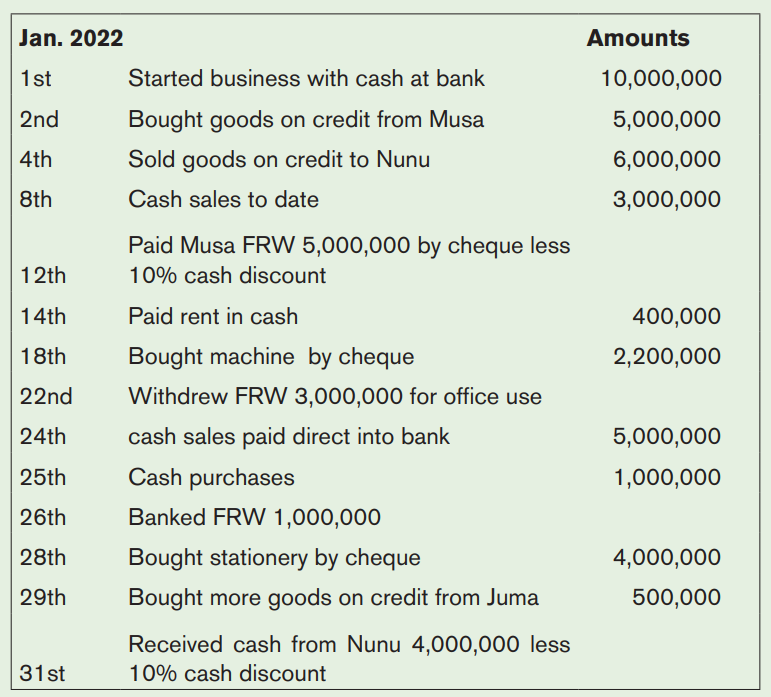
3.8 Petty Cash Book
Activity 3.8
BAHIZI is a Wholesaler in Nyarugenge Matheus, selling electronic items
import from CHINA. In order to avoid holding big amount of money in his
office, he uses cheques in all business transactions, including receipts and
payments. Few days later, he failed to handle small expenses which normally
require the use of cash other than cheques. In your groups, discuss the
simple way may be used to handle those small expenditure.
3.8.1 Petty cash
The cheque has become a very important means of settling business accounts,
such that most payment requiring large sum of money are made by cheque.
Nevertheless, there are certain accounts that require small amounts for
settlement. Expenses for the kitchen, cleaning, postage etc. are settled by small
amounts of money which usually are not done by cheque. Sometimes, items
like stationery, travelling expenses, small ledger accounts, advance to casual
workers, etc. are required urgently and the procedure for preparing a cheque for
the purpose is rather long. The alternative is to keep in the office to meet minor
and urgent expenses is called petty cash, float or imprest. The clerk in charge of
handling petty cash payments is known as a petty cashier
3.8.2 Petty cash voucher
This is a specially designed form used by a petty cashier. It states the nature of
payment the amount, date, the authority for the payment and the person to be
paid to. It also acts as evidence for receipt of such cash as the recipient must
sign it immediately after receiving the cash. It should be numbered serially. Petty
cash vouchers are used as source of information for recording the petty cash
book, which records petty transactions.
3.8.3 The petty cash book
This is the book of account in which petty cash transactions are recorded. The
petty cashier is provided with a strong cash box in which the petty cash is kept
and locked in a drawer. The patty cashier also keeps payment vouchers which
serve as source documents for information to be recorded in the petty cash
book. The vouchers state the date for payment brief details of the nature of
payment, the amount of payment, the recipient of the money, the authority for
payment, payments analysis etc.
Each recipient of petty cash fund must fill in and sign a petty cash voucher
which is the checked and approved by the accountant before cash is paid out.
The petty cashier must retain the payment voucher as evidence of the payment.
At all times, the total of amount appearing in the payment vouchers and the
balance of cash in hand in the cash box should add up to the original amount of
money given to the petty cashier as petty cash.
The petty cash book is a book of original entry and an account for petty cash
transactions. Petty cash transactions are first recorded in this book before being
posted to the ledger. It forms a separate ledger book.
The petty cash book is ruled in columns. The debit side has got columns for
date, folio, details and amount, while the credit or payment side has got columns
for date, details, folio, a total amounts column, plus analysis columns in which
various petty cash payments are analyzed such as sundry expense, stationery
and postage, telephone and telegrams etc. the debit side records the amount of
money received as petty cash plus any petty cash in hand brought forward from
previous period. The credit side records payments made out of petty cash and
each day’s payment is analysed in the relevant column. The daily total is posted
to the total payments column. At the end of the period, the amounts in the
analysis columns are added. The sum of the analysis column totals should agree
with the sum of the totals column. The difference between the sum of the total
payments column and the amount received column on the debit side represents
the balance of petty cash in hand carried forward to the next period. There is an
automatic check of the petty cash book as horizontal totals and vertical totals
must agree. The following example illustrates the ruling and preparation of the
petty cash book.
MUVUNYI keeps a petty cash book. On 1st January 2022 his petty cash was
given as FRW 240,000 and he made the following payments in the course ofthe month
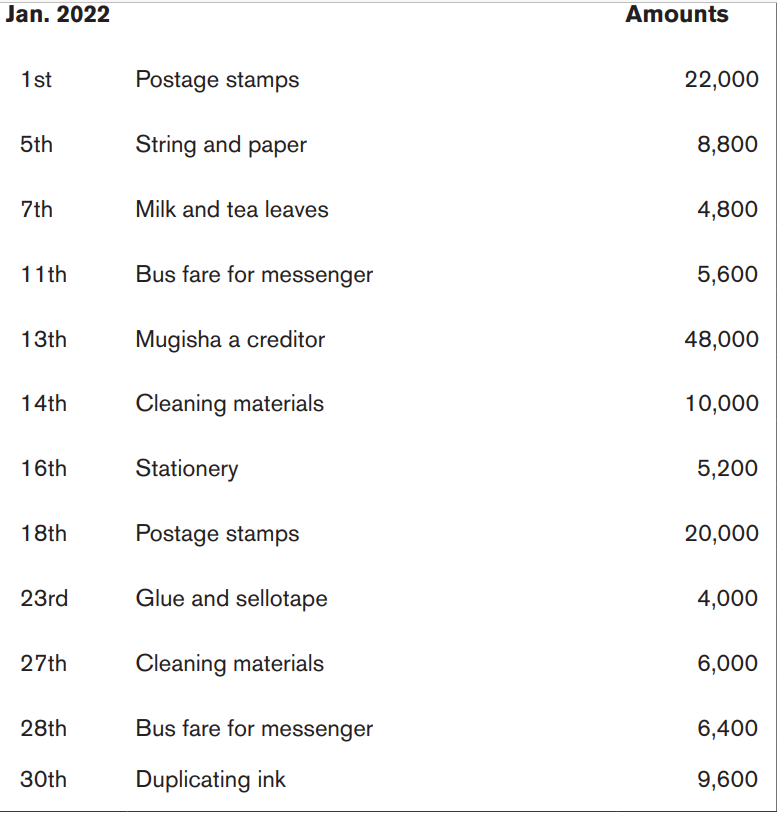
Required:
a) Enter the above transactions in a suitable ruled petty cash book for the
month of January and show the balance of petty cash in hand on 31st
January 2022. Use appropriate analysis columns.b) Post total columns to their relevant ledger accounts
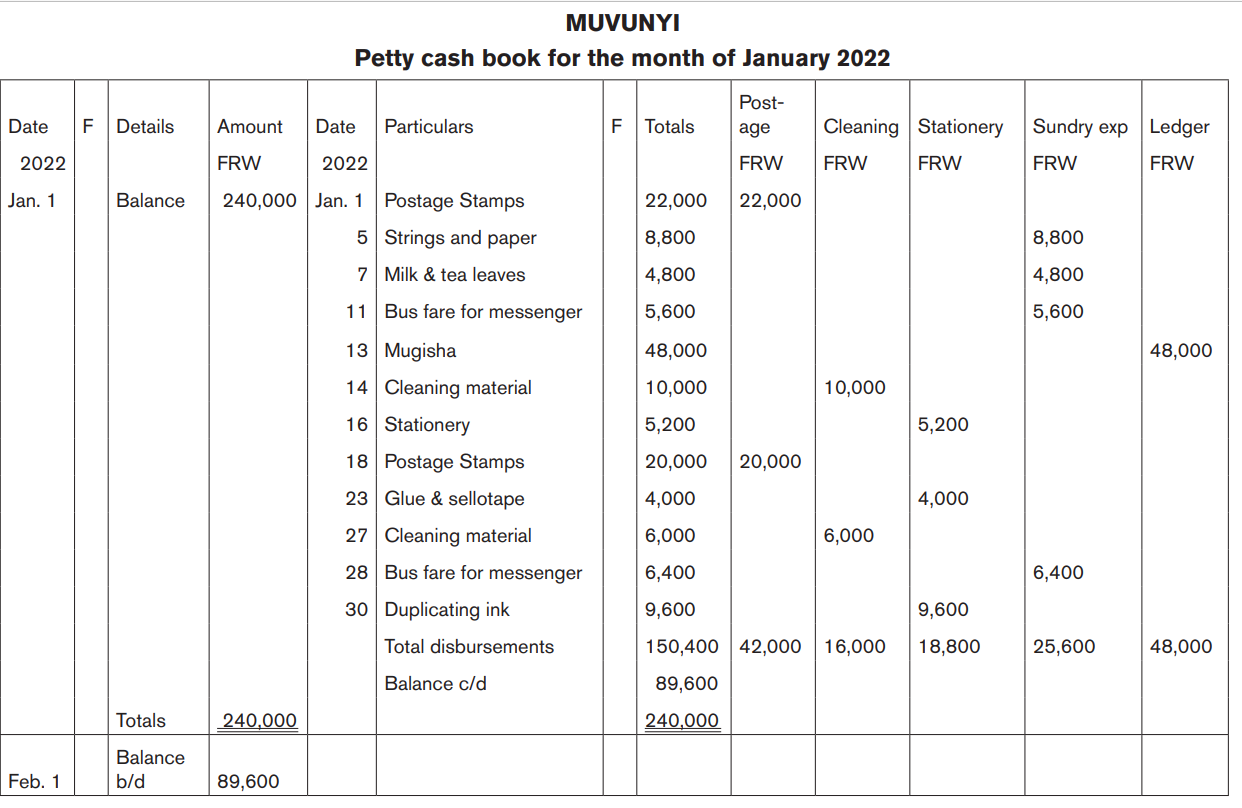
3.8.4 The Imprest System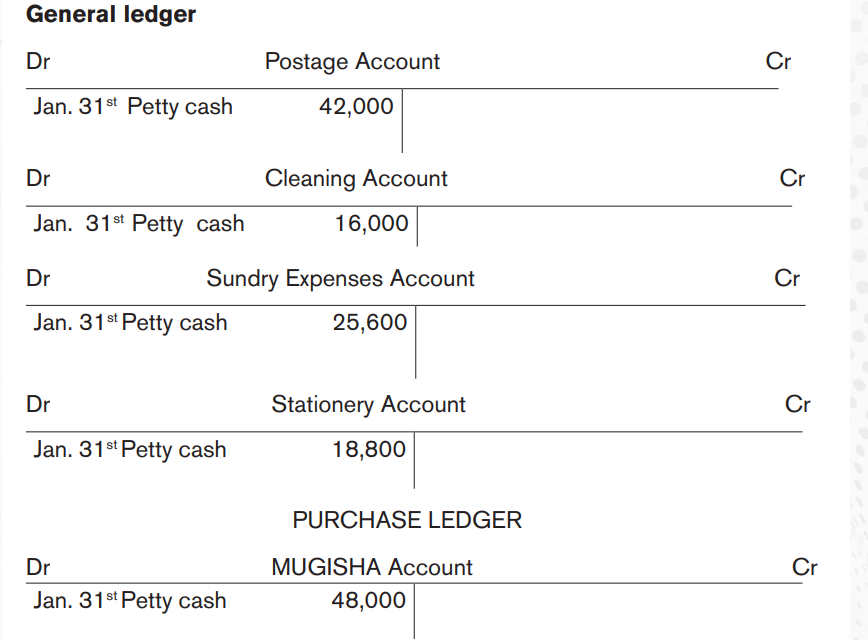
This is the modern system of keeping petty cash. Under the imprest system, a
petty cashier is provided with a fixed sum of money at the beginning of a given
period out of which petty cash payments are made. At the end of each balancing
period, the petty cashier is given a sum of money equal to the payments or
disbursements made during the period.
Features of the Imprest System
a) At any time, the sum of the petty cash in hand plus disbursements
as shown by the payment vouchers should always equal the original
amount given to the petty cashier
b) The amount of money to the cashier to restore the imprest is the total
of the payment vouchers or disbursements. This amount plus the
petty cash in hand automatically restores the initial imprest. The act
of restoring the imprest is also called reimbursement, or renewing the
float, as imprest is also called sometimes.
c) Total disbursements are equal to the cash or cheque debited in thepetty cash book to restore the imprest.
d) Double entry is exercised between the petty cash book, the cash book
and nominal expenditures.
1) Petty cash advance:
Dr: Petty cash A/C
Cr: Cash A/C
2) Monthly Payments:
Dr: Nominal A/C
Cr: Petty cash A/C
3) Reimbursement:
Dr: Petty cash A/C
Cr: Cash A/C
Advantages of the Imprest System
1. It makes it easy to verify the arithmetical accuracy of the cash book by
using the horizontal and vertical analysis column totals; cross- casting.
2. The petty cashier is always accountable for the imprest amount
3. The system facilitates good internal control as at any given time the petty
cashier’s cash in hand plus the amount paid as shown by the payment
vouchers must always add up to the imprest amount.
4. Deficiencies are limited at any time to the balance of imprest cash not
yet spent.
5. Usage of the system allows for sound cash management.
Advantages of Using Petty Cash System
1. It allows the recording of cash items in the cash book to be more objective
yet tidy. The petty cash items, involves small amounts, which can cause
a lot of entries in the cash book that would make it hard to manage,
especially in a busy business environment.
2. The use of this system allows limited cash to be in the business premises.
This ensures that only a limited amount may be lost in case of theft, as the
bulk of it will have been banked.
3. It facilitates day to day activities to run smoothly since urgent issues
requiring small cash amounts can be handled quickly instead of waiting
for long process of approving and signing cheques for various payments.
4. It creates flexibility in the organization’s cash management.
5. It saves time because the small cash payments are delegated to the petty
cashier while the accountant concentrates on other major issues in the
business entity.
6. It helps to control the flow of expenditure easily, especially cash
expenditure.
Amounts in the analysis columns for payments are posted to their respective
ledger accounts to complete the double entry. The balance in the petty cash
book appears in the trial balance as an asset and in the balance sheet among
current assets, proving further that the petty cash book is both a book of original
entry and a ledger book.
Example 2:
HABINEZA maintains a petty cash book on the imprest system. The imprest
being FRW300,000. The following transactions took place in February 2022.
Feb.1st Received imprest from the cashier of FRW 300,000
3 Bought postage stamps of FRW 20,000
7 Bought stationery FRW50,000
8 Paid travelling allowance FRW 40,000
10 Paid window cleaning expenses FRW 60,000
12 Paid Runner’s account in the purchases ledger FRW 50,000
14 Paid subscriptions for trade association FRW 20,000
17 Paid office cleaning expenses FRW 20,000
18 Received FRW 300,000 from the cashier
19 Paid for travelling expenses FRW 100,000
22 Bought electric light bulbs FRW 20,000
25 Paid Runner’s account in the purchases ledger FRW 25,000
26 Paid travelling expenses FRW 10,000
27 Paid for sugar, tea and milk FRW 30,000Required:
Enter the transactions into a petty cash book under the analysis column: Postage
and stationery, travelling expenses, sundries and a ledger column. Balance the
cash book showing the reimbursement required to restore the imprest and thebalance brought forward at 1st March 2022
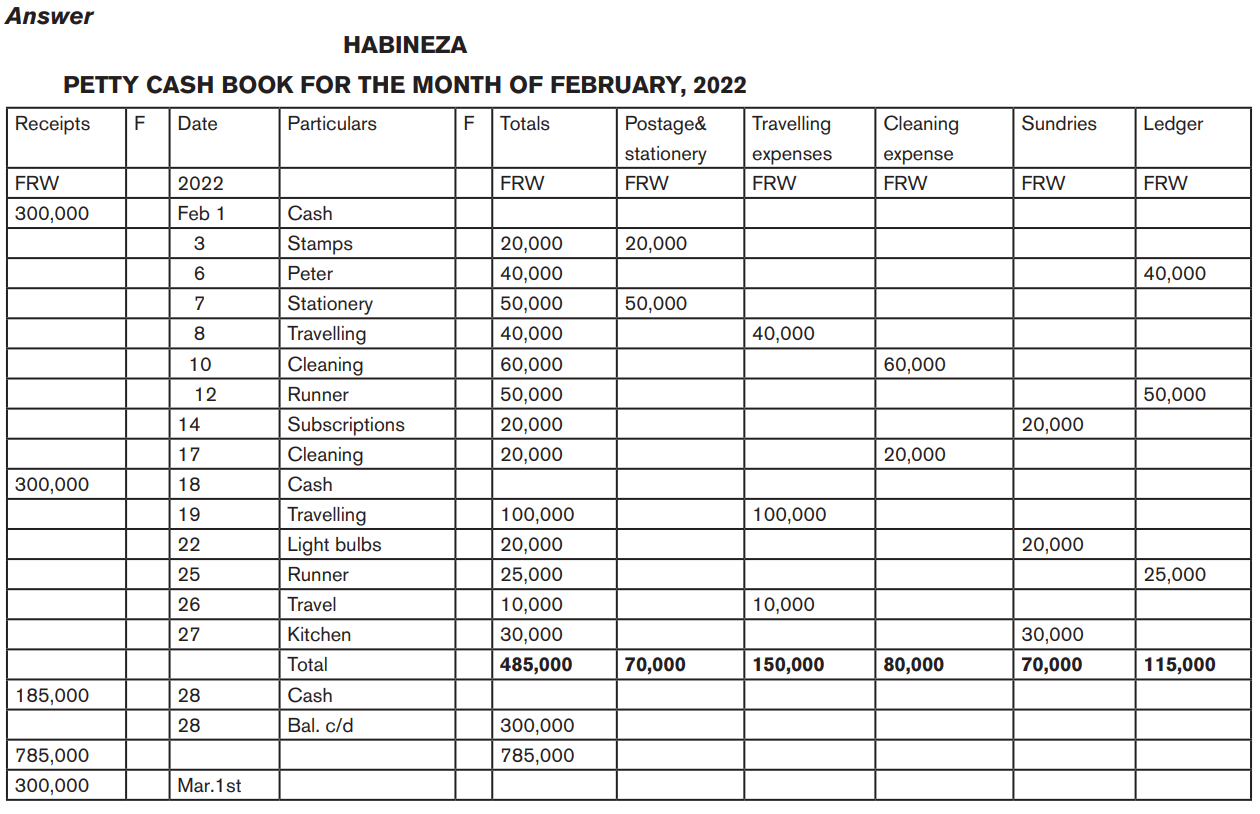
Application activity 3.8
- 1. State the advantages of using imprest system of petty cash
- 2. Mark NDUWAYEZU is a sole trader in a business know as MANDU
- Traders Ltd. He keeps his petty cash on an imprest system, amount
- being FRW 200,000. The following are the petty cash transactions
- for the month of March 2022.
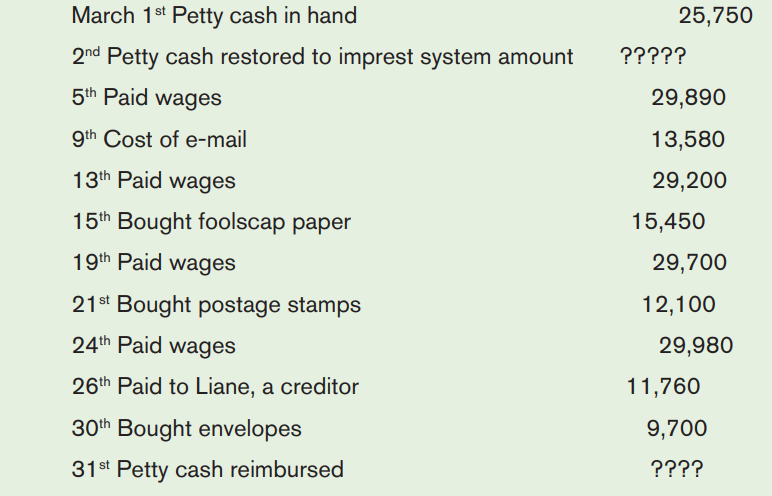
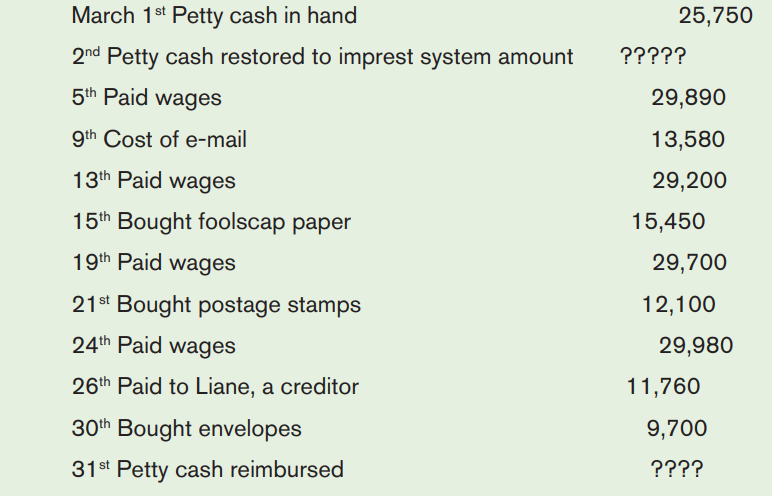
Required:
1. Write up the petty cash book to record the above transactions,
showing the entries restoring the petty cash imprest amount
2. Post relevant entries into the ledger.
Notes : your analysis columns should show:
a) Wages
b) Postage and telegrams
c) Stationery
d) Ledger
End of unit assessment
MUGISHA commenced a stationery business on 1st January, 2022 with his
salary savings of FRW 50,000,000 which he was keeping with BANK OF
KIGALI. He transformed his personal account into a business account and
there after the salary had to be channeled to his account with I&M Bank.
He also took his sister as his assistant in the business and she was to be
paid a salary of FRW 500,000 per month.
During the month of January, he carried out the following transactions:
Jan. 1 He withdrew FRW 10,000,000 for use in day-to-day operations of
the business.
Jan. 2 Bought stationery worth FRW 15,000,000 from KBG Stationers
on credit, and also transferred his furniture worth FRW 10,000,000 from
home for use in the business.
Jan. 3 Bought further stock of stationery at FRW 18,000,000 and paid by
cheque. He also paid FRW 1,500,000 for transporting the stationery to the
place of work paying cash.
Jan. 5 Cash sales were FRW 8,000,000. He also sold stationery to Lycée
de Kigali at FRW 14,000,000 on credit.
Jan. 7 Paid KBG Stationers FRW 9,000,000 by cheque for stationery
previously bought, and returned some spoilt stationery worth FRW 700,000
on the same day.
Jan. 10 Bought Stationery at worth FRW 20,000,000 from Kigali Stationary
LTD on account.
Jan. 13 Lycée de Kigali paid FRW 6,000,000 by cheque and returned
some items worth FRW 800,000 which had not been ordered for.
Jan.20 Sold books worth FRW 23,000,000 to FAWE Girls School on
condition that payment is made before the end of the month.
Jan. 25 Paid salary to his assistant by cheque.Required: To record the above transactions into the books of original entry
